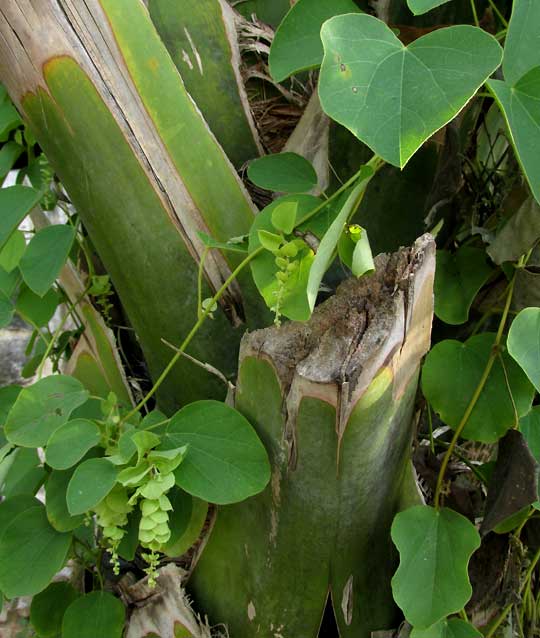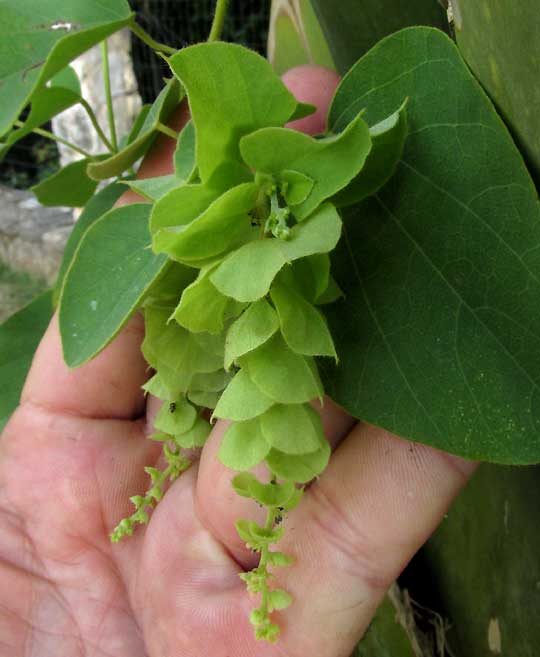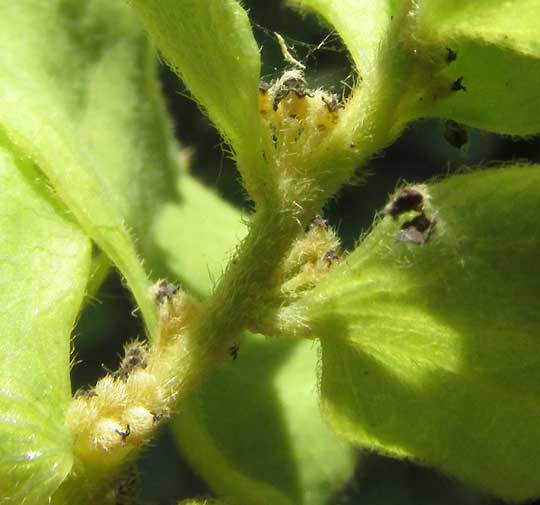Excerpts from Jim Conrad's
Naturalist Newsletter
from the August 16, 2015 Newsletter issued from Yuxunah, 20kms southwest of Chichén Intzá, Yucatán, MÉXICO
VELVET-LEAF VINE
Yaxunah's street sides are weedier than normal, but it's not the kind of weediness seen closer to big towns and important roads. A lot of the weeds -- sometimes I think most of them -- are useful plants, which Yaxunah's plant-savvy population is too well informed to remove. Below you can see such a common weed, a vine growing up through the petioles of a Mexican Palmetto (one of the Huano thatch palms, so probably the severed petiole is from someone patching their roof with a frond from this tree) along a street:

The heart-shaped leaves with several conspicuous veins arising from the blades' bases well could be those of a morning-glory. However, the leaves' covering of dense, soft hairs give a soft, fuzzy feeling, and that's a field mark I don't recall for any morning-glory species. Also, those clusters of pale green items -- looking a little like upside-down pagodas -- aren't found on any kind of morning-glory. A closer look at a cluster is shown below:

You might guess that the dangling clusters are composed of bracts, and normally at the base of such bracts flowers arise. In this vine's case the flowers are tiny, as you can see below:

The arrangement of these flowers was hard to interpret. I couldn't figure out what was going on until the plant was identified and a botanical manual described how the family arranged it flowers. The family is the Moonseed Family, the Menispermaceae, which produces unisexual flowers on separate male and female plants (the plants thus "dioecious"). The tiny flowers in our picture are all female ones, and are arranged in few-flowered clusters at the base of each bract, with each flower normally bearing 3-6 separate pistils.
Therefore, in the above picture, each item that looks like a hairy, pear-shaped ovary with three or so blackish styles is actually a single female flower bearing three or so separate, one-styled pistils crammed so close together that they look like one ovary with three or so styles. A diagram of such a single flower with several pistils -- which will develop into an "aggregate fruit" such as a blackberry -- as shown on our Aggregate Fruit Page.
So, our fuzzy-feeling vine, which grows from a woody base and reaches 16 feet high (5m), is CISSAMPELOS PAREIRA, sometimes in English known as Velvet-leaf, along with several other unrelated plants also with soft-hairy leaves. In Maya Velvet-leaf Vine is called X-peteltun, and I suspect that one reason it's so commonly occurring along Yaxunah's streets is that it's a well known medicinal plant.
Locally the vine's fresh leaves are boiled in water to brew a tea for treating diarrhea, while dried leaves are boiled to make a tea for stomach ache. Elsewhere in Mexico the plant is used especially for problems of the urinary tract, particularly distention of the bladder, as well as for other ailments such as what used to be known as rheumatism, jaundice, and dropsy.
Velvet-leaf Vine grows from Mexico south to Panama.